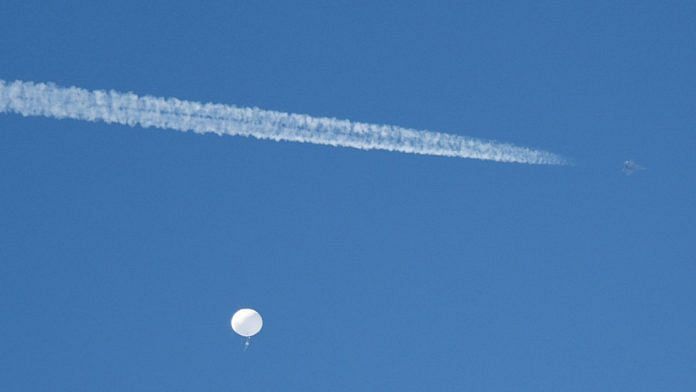On 1 February, a high-altitude balloon of Chinese origin was spotted over the US state of Montana, which also houses one of the country’s three active nuclear missile silos. The US government officially described it as a surveillance balloon with no immediate military or physical threat but was quick to go back on its initial assessment. Despite Chinese claims that the balloon was a harmless “civilian airship” that had unintentionally flown into US airspace, on 3 February, Secretary of State Antony Blinken cancelled his much-anticipated diplomatic visit to Beijing. Subsequently, on 4 February, US forces shot down the balloon over the country’s South Carolina coast and are now proceeding to collect some of the debris.
Not just China, the US has also experimented with utilising high-altitude balloons in space for a long time. In July 2022, NASA tested an aerial robotic balloon that would work in tandem with an orbiter to carry out scientific measurements of Venus. In August 2022, the UK selected an American company to demonstrate an uncrewed platform for stratospheric communications, intelligence, surveillance and reconnaissance (ISR). The need was for manoeuvrable, long-duration missions capable of locating targets anywhere on earth.
An American view describes the Chinese balloon incident as part of a larger, more troubling pattern. To better understand the possibilities of using the stratosphere for command and control, surveillance, communications and intelligence, read this article by Lt Gen PR Shankar (Retd). Balloons could prove much cheaper and loiter for extended periods, providing continuous surveillance over targets, unlike satellites based on orbital motion. Welcome to the space race gaining ascendancy as part of a larger global geopolitical struggle—one with profound implications for India.
Also read:
Beginning of a third World War?
There should be hardly any doubt that the chances of military incidents in space, air, and maritime domains are growing. If the Ukraine War could—even if unwittingly—draw in NATO, ‘God only knows’ what else it could lead to.
Has the third World War started? We may never know, except in hindsight. And even then, historians—if there are survivors—would probably contend when the war began.
It is unfortunate that a balloon, which, according to initial US statements, did not pose a threat, has postponed a dialogue direly needed to reverse the course on pathways that cannot lead to happy endings for the world. The US has said that the balloon issue is a matter of violation of sovereignty, and, as of 4 February, there are reports of another balloon being spotted over South America that China has admitted is also theirs.
If viewed from a historical perspective, the world is back to its default mode, only this time, it has a different set of actors. It involves various forms of power, primarily shaped by technology. Notably, there exist also nuclear weapons in the hands of nine powers, unlike during the Cold War era, when the number was confined to five. However, economic and technological integration is much greater than ever before. Ever since Russia invaded Ukraine in 2022, attempts at desegregating economic and technological fields have not just continued but also gained momentum. Global cooperation is in short supply and is being morphed into a coalition-building exercise ensconced in primarily two camps—led by the US and China.
Also read:
India’s posture in a polarised world
After China’s aggression on the northern borders, India has tilted to the West, especially in the maritime and technological arenas. Economically, it has maintained trade with China and benefited from lower-cost energy supplies from Russia. But as global tensions grow and confrontations increase, India could find itself under pressure to take sides even when itsinterests are not under contention. It is difficult to estimate if and when that milestone will be reached. Therefore,there is a need to articulate a foreign policy paper on India’s alignment posture in a world that is becoming increasingly polarised.
This policy must foster partnerships based on context and not on blocs. India could join hands with the US and its allies in seeking an open and rules-based Indo-Pacific order. It could evenpartner with China on climate change if there is a congruence of interests. In grand strategic terms, India’s challenge is to avoid being dragged into a World War that must be considered a growing possibility.
Also read:
India as peacemaker
What could be at the back of the Indian strategic mind is to play the role of a peace broker and explore every possibility to make it count. This is important because the state of relations between the US and China does not seem to have many prospects for a return to dialogue that can facilitate consensus on bilateral, multilateral and global issues. It is a possibility reflected in the inability of the United Nations to intervene, as the major parties involved are themselves in contention for the position of the stronger superpower.
India may be getting into a position to make a peacebuilding attempt, and this report by a US-based business intelligence consulting firm corroborates this assertion. According to this survey, Prime Minister Narendra Modi is among the world’s most popular global leaders. With a 78 per cent approval rating, Modi is far ahead of other contenders.
If appearances count, for some time now, our prime minister has been sporting a beard that dovetails with a peacemaker image and not with an earlier pugnacious one. It is time that Indian strategists explored the feasibility of making India a peacebuilder. It is a daunting and challenging task that may look unachievable. But that is no reason for not trying, as Modi has popularity—both internal and external—on his side.
Lt Gen (Dr) Prakash Menon (retd) is Director, Strategic Studies Programme, Takshashila Institution; former military adviser, National Security Council Secretariat. He tweets @prakashmenon51. Views are personal.
(Edited by Zoya Bhatti)






